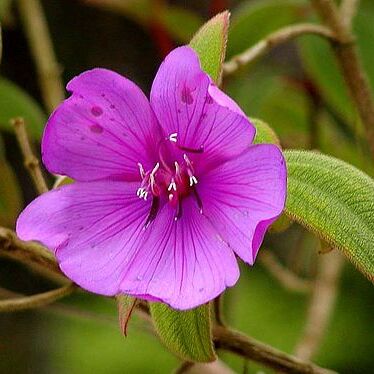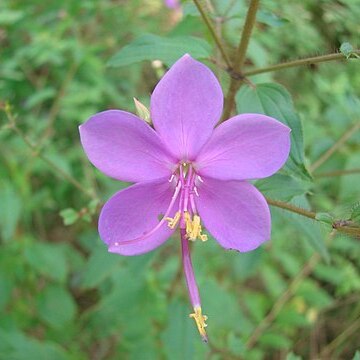Trees, shrubs or more commonly herbs, rarely climbers, sometimes epiphytes. Leaves opposite and decussate, rarely verticillate, sometimes anisophyllous, simple to entire, serrate, exstipulate, usually with a distinctive nervation of 2–8 strong basal nerves ± parallel to the midrib, rarely pinnately nerved. Inflorescences various, sometimes bracteate. Flowers hermaphrodite, regular (androecium sometimes slightly zygomorphic), mostly 4–5(–6)-merous. Calyx tubular or campanulate, free or partially adnate to the ovary or sometimes connected to it by septa-like strands (no distinction is made here between the hypanthium and calyx proper); lobes valvate or connate and forming a calyptra-like head in bud, deciduous or persistent; various appendages may alternate with or arise from the calyx-lobes. Petals 4–5, free or rarely united at the base, imbricate or convolute, often magenta coloured. Stamens perigynous or epigynous, as many as the petals or more usually twice as many as the petals and in 2 whorls, the whorls equal to very unequal; anthers usually 2-thecous, introrse, basifixed, each anther dehiscing by a single pore or more rarely by a slit (Memecylon); anther-connectives often elongated and often either tubercled or spurred at the junction with the filament; filaments often geniculate, inflexed in bud, sometimes twisted. Ovary 1-locular with basal placentation >i>(Memecylon) to several-locular with axile placentation; ovules usually numerous; style and stigma 1. Fruit a loculicidal capsule or a berry. Seeds small or minute, without endosperm and with a very small embryo; one cotyledon larger than the other
Herbs, shrubs, trees or lianes. Leaves simple, entire, opposite, rarely alternate or verticillate; veins usually longitudinal, occasionally penninerved or 1-nerved, exstipulate; petiole variously well developed to absent. Inflorescences terminal, axillary or cauline, in various compound to reduced cymes, occasionally flowers solitary. Flowers actinomorphic, bisexual, rarely unisexual, usually 4-or 5-merous. Hypanthium campanulate to narrowly ovoid or turbinate, with scales, emergences or hairs, or glabrous. Calyx lobes long and triangular to indistinct, or absent. Petals commonly obovate, sometimes showy. Stamens usually twice the number of petals, of 1 basic shape (isomorphic) or 2 (anisomorphic); anthers long-linear, sometimes rostrate, to short or dolabriform, commonly with 1, rarely 2, terminal pores, or with 2 or 4 lateral slits; connective often shortly to distinctly prolonged below anther locules, and with a distinctive ventral and/or dorsal appendage. Ovary usually inferior, 4-or 5-locular, or sometimes 1-locular; ovules numerous, occasionally few, on axile, basal or free central placentas, rarely parietal; style simple; stigma capitate or punctate. Fruit a capsule, sometimes subfleshy, or a berry. Seeds numerous, occasionally 1 (rarely 2), variously cochleate, cuneate or globose.
Stamens epigynous, rarely perigynous, twice as many or rarely as many as the petals; filaments free, inflected in the bud; anthers basifixed, 2-locular, dehiscing by 1 apical pore (rarely by 2 and very rarely by 4) or by 2 longitudinal slits; connective produced or not at the base and provided anteriorly and/or posteriorly with appendages of several types
Ovary 2-¥-locular or 1-locular by suppression of the dissepiments (Memecylon), glabrous, setose or with scales at the apex; style 1, terminal, straight or curved with a dot-like or subcapitate stigma; ovules anatropous
Stamens the same to double the number of the petals; filaments free, often geniculate, inflexed; anthers 2-celled, opening by a pore at the apex or rarely by a slit (Memecylon), connective often appendaged at the base
Seeds minute, cochleate, cuneiform, pyramidal or cylindrical in the many-seeded genera and globose or hemispherical in the few-seeded ones; embryo subcylindric or sub-globose, without endosperm
Fruit a many-seeded capsule, sometimes baccate, included in the receptacle, rarely semiexserted, opening by loculicidal valves, rarely dehiscing irregularly, or a berry, 1-few-seeded
Perennial or annual erect or prostrate terrestrial or epiphytic herbs, lianes, shrubs or trees, with a variable indumentum or glabrous
Calyx tubular, free or adnate to the ovary, or sometimes connected to it by septa-like strands; lobes imbricate or rarely valvate
Petals as many as the sepals, inserted on the margin of the receptacle, very rarely connate at the base, imbricate or contorted
Leaves opposite or sometimes verticillate, longitudinally (1)3–5–7(1 l)-nerved, rarely penninerved, simple, without stipules
Sepals imbricate or rarely subvalvate, caducous or persistent, rarely 0; intersepalar segments sometimes present
Ovary mostly inferior, 1-to many-celled; style simple; ovules numerous, axile, or rarely basal or parietal
Leaves simple, opposite or verticillate, mostly with 3 to 9 longitudinally parallel nerves; stipules 0
Flowers in cymes, arranged in heads, fascicles or in ± ample panicles, rarely flowers solitary
Flowers actinomorphic or zygomorphic as regards the stamens, bisexual, (3)4–5(6)-merous
Receptacle free or adherent to the ovary by longitudinal ridges or ± adnate to it
Flowers hermaphrodite, mostly very showy, actinomorphic
Petals imbricate, free, rarely united at the base
Herbs, shrubs or trees; branches opposite
Seeds minute, without endosperm
Corona sometimes present
Fruit a capsule or berry


